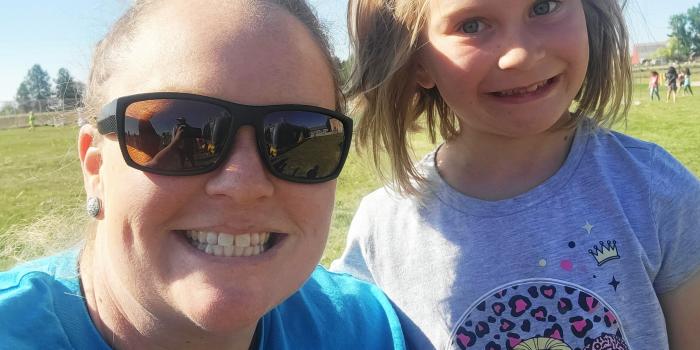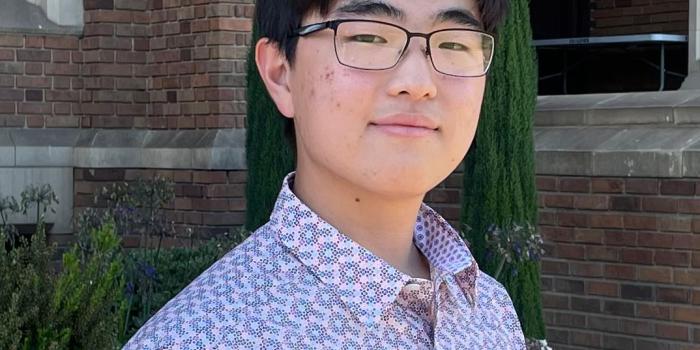
Epidermolysis Bullosa Simplex (EBS) is the most common form of EB, defined by recurring blistering in the upper layer of the skin—specifically within the basal layer of the epidermis.
Symptoms often begin at birth or early infancy and may become more prominent with activity such as kicking or crawling. EBS is a lifelong condition that can range from localized blistering on the hands and feet to more widespread involvement, potentially affecting other organs and impairing mobility. Everyday friction, heat and humidity are common triggers. Navigate to a specific section by clicking the links below:
"I am 64 years old and have lived my entire life with EB Simplex (EBS). I mainly blister on my feet and hands...It's always a balance in life. Most people I know don't think twice about walking, but I often have to."
Woody, Living with EB Simplex
Signs and Symptoms
Epidermolysis Bullosa Simplex (EBS) is characterized by blistering of the skin, which occurs when the skin is subjected to friction, rubbing, or minor trauma. The severity of symptoms can vary widely between individuals, even within the same subtype. Hallmark signs and symptoms of EBS include:
- Chronic blistering: The hallmark of EBS, blisters typically appear on the skin's outer layers (epidermis) and can be painful, prone to infection, and may interfere with mobility and daily activities.
- Sores and Wound Progression: Blisters may continue to expand and accumulate fluid, unlike typical blisters, resulting in open sores or wounds. In more severe cases, blistering can occur on mucous membranes, such as the mouth, eyes, or throat, leading to additional discomfort and secondary complications.
- Localized or Widespread: In milder forms of EBS, blistering may be limited to specific areas (e.g., hands or feet), while in more severe cases, it can affect large portions of the body.
- Hyperkeratosis (Thickened Skin): Thickened, callus-like skin can develop, particularly on the palms and soles, due to repeated trauma. This can result in a hardened appearance and increased discomfort.
- Nail Changes: Some individuals with EBS may experience nail abnormalities, such as nail loss, thickening, or deformities.
- Mucosal Involvement: In certain cases, blisters may appear on mucous membranes, such as inside the mouth or esophagus, causing difficulty swallowing or eating.
- Scar Formation: While scarring is typically not a common feature of most EBS types, some individuals with more severe cases may experience scarring as a result of frequent blistering.
Subtypes of EB Simplex
Localized EB Simplex
Localized EBS (previously known as Weber-Cockayne) is the most common and mildest form of Epidermolysis Bullosa Simplex. Blistering usually begins at birth or in early infancy, affecting specific areas like the hands and feet - especially after physical activity, heat, humidity, or sweating.
The blistering occurs in the upper layer of the skin (intra-epidermal) and heals without scarring, though darkened areas (hyperpigmentation) may appear after healing. Over time, especially by adolescence, blistering may become less frequent and more localized.
Specific Features
Most often seen on hands and feet, especially after friction or heat.
Small white cysts that can appear in the first weeks of life.
Thickened, hardened skin on the soles of the feet that can become painful and limit mobility.
Toenails or fingernails may become unusually thick or misshapen.
Large, dark, irregular birthmark-like patches that may form where blisters have repeatedly healed. These are benign but may resemble melanoma.
Intermediate EB Simplex
Intermediate EBS (previously known as EBS generalized-intermediate or EBS Koebner) presents similarly to localized EBS but is characterized by more widespread blistering compared to the localized subtype. Skin usually heals without scarring, though darkened areas (hyperpigmentation) may appear after healing.
Specific Features
Blisters typically begin in infancy and may lessen with age, sometimes becoming more limited to the hands and feet during adolescence.
Unlike localized EBS, blistering is not limited to hands and feet and can appear anywhere on the body.
Thickening of the soles of the feet can develop gradually, become painful, limit mobility, and impact quality of life.
Tiny white bumps (milia) often appear within the first few weeks of life.
Large, dark, irregular birthmark-like patches that may form where blisters have repeatedly healed. These are benign but may resemble melanoma.
Nails may appear thick, damaged, or dystrophic, and in some cases, they may become loose or fall off. Nails may grow back, though repeated damage may lead to permanent loss or abnormal regrowth.
Severe EB Simplex
Severe EBS (previously known as EBS generalized severe or EBS Dowling-Meara) is the most severe subtype of EB Simplex, marked by widespread and often spontaneous blistering that begins at birth. Skin is extremely fragile, and blisters can form with minimal or no trauma.
While the most severe symptoms typically subside after infancy, many individuals continue to experience chronic skin issues and complications that require lifelong management.
Specific Features
Widespread and severe, including large blisters that may appear spontaneously or from very light friction, such as a diaper on the skin.
Blistering often affects the mouth and mucous membranes, which can impact food intake and dental issues.
Severe thickening of the skin on the palms and soles is common, often significantly impairing mobility.
Develops gradually and can limit walking or daily activity.
Tiny white cysts may be present from the first weeks of life.
Dark pigmented moles often appear in areas of repeated blistering.
Nails may be thickened, damaged, or missing.
May require medical treatment to manage.
May experience growth delays, likely due to feeding issues, energy demands of wound healing, and chronic inflammation.
In the neonatal period, large, tense blisters and congenital ulcerations are common. The condition may be life-threatening in infancy due to extensive skin damage and related complications.
Other EB Simplex Variants
In addition to the more common forms of Epidermolysis Bullosa Simplex, there are several less common and distinct subtypes that present with unique challenges.
Noted Clinical Symptoms
- Skin blistering starts at birth and is generalized, of intermediate severity.
- Mottled or reticulate pigmentation develops gradually
- Focal keratoses of the palms and soles, and dystrophic, thickened nails occur over time.
Genetics
- Autosomal dominant inheritance.
- The keratin 5 monoallelic pathogenic variant c.74C>T, p.P25L typically causes this phenotype,13 but cases with other variants in KRT5, KRT14 or EXPH5 have been reported.
Noted Clinical Symptoms
- Multiple vesicles are present from birth onwards and acquire over time a typical circinate migratory pattern on an erythematous background; post-inflammatory hyperpigmentation develops gradually and may have a mottled pattern.
- Nails may be dystrophic.
Genetics
- Autosomal dominant inheritance.
- Monoallelic pathogenic variants in KRT5 which affect the variable 2 domain and result in frameshift and elongated keratin 5 polypeptide cause this phenotype.
Noted Clinical Symptoms
- Extensive skin defects on the extremities are present at birth and heal with hypo- and hyperpigmentation and skin atrophy, initially resembling burn-like scars. Skin blistering diminishes in adulthood, but fragility persists, with erosions occurring after minimal mechanical trauma.
- Diffuse or focal plantar keratoderma.
- Nail thickening and onychogryphosis.
- Diffuse alopecia has been reported in some adult patients.
- Dilated cardiomyopathy has been reported in young adulthood. Laboratory screening (pro-BNP, creatine kinase, creatine kinase MB) should be started as early as the age of 2 years, with yearly follow-ups. If pathologic values are found, cardiologic examination, ECG and cardiac ultrasound should be performed.
Genetics
- Autosomal dominant inheritance.
- Monoallelic pathogenic variants in the translation initiation codon of KLHL24, coding for the kelch-like member 24 cause this disorder.
- High rate (50%) of de novo mutations.
Noted Clinical Symptoms
- Skin blistering starts at birth and is generalized and severe in most cases. No improvement of cutaneous fragility is expected with age. Healing of lesions leads to post-inflammatory hyperpigmentation.
- Absence of keratin 5 leads to widespread blisters and erosions and early lethality.
Genetics
- Autosomal recessive inheritance.
- Biallelic nonsense, missense or frameshift KRT14 pathogenic variants.
- Biallelic loss-of-function or missense KRT5 pathogenic variants.
Noted Clinical Symptoms
- Skin blistering starts at birth or in childhood and is mostly localized to acral extremities.
- Plantar keratoderma.
- Nail dystrophy.
Genetics
- Autosomal recessive inheritance.
- Biallelic loss-of-function pathogenic variants in DST lead to absence of BP230 and cause this subtype.
Noted Clinical Symptoms
- Generalized skin blistering starts at birth or in infancy. Blistering tendency may diminish with age, while crusts and scabs reflect the fragility of the skin.
- Mild mottled pigmentary changes may develop.
Genetics
- Autosomal recessive inheritance.
- Biallelic loss-of-function pathogenic variants in EXPH5 lead to absence of exophilin 5 and cause this subtype.
Noted Clinical Symptoms
- Skin blistering starts at birth, is mainly acral but may be widespread. The autosomal dominant subtype is characterized by a mild course, mainly acral erosions and postlesional violaceous and hypopigmented macules. Only three cases with the autosomal recessive subtype have been published yet, all of intermediate severity.
- Plantar keratoderma.
- Dystrophic thickened nails, sometimes onychogryphosis.
- No muscular dystrophy.
Genetics
- Autosomal dominant or recessive inheritance.
- The monoallelic PLEC pathogenic variant, c.5998C>T, p.R2000W causes the autosomal dominant subtype previously known as EBS Ogna.
- Biallelic pathogenic variants in the exon 1a of the PLEC1a isoform (expressed in skin, but not in muscles), in particular, c.46C>T, p.R16*, cause the autosomal recessive subtype.
Noted Clinical Symptoms
- Generalized skin blistering starts at birth and is of intermediate severity. Blistering tendency diminishes with age.
- Focal plantar keratoderma.
- Nail dystrophy and loss.
- Mucosal involvement including oral, ocular and urethral mucosae is common.
- Dental anomalies.
- Muscular dystrophy starts at a variable age, ranging from infancy to adulthood.
- Cardiomyopathy may be associated.
- Granulation tissue and stenosis of the upper respiratory tract and hoarseness may occur.
- Muscular dystrophy is usually life-limiting in childhood or early adulthood.
- Pyloric atresia may be associated in rare cases.
Genetics
- Autosomal recessive inheritance.
- Biallelic loss-of-function pathogenic variants in PLEC coding for plectin cause this phenotype. They result in lack of immunoreactivity for plectin and a plane of cleavage deep within the basal pole of the basal keratinocytes.
Noted Clinical Symptoms
- Widespread full-thickness congenital absence of skin.
- Pyloric atresia.
- Involvement of the oral mucosa.
- Anemia and growth retardation.
- Neonatal lethal course.
Genetics
- Autosomal recessive inheritance.
- Biallelic loss-of-function pathogenic variants in PLEC cause this phenotype.
Noted Clinical Symptoms
- Only a few individuals with this subtype have been reported so far in the literature.
- Skin blistering starts at birth and is widespread primarily in the pretibial area but also scattered on other parts of the body, particularly those exposed to trauma.
- Facial freckling, poikiloderma and atrophy of the skin, and acrogeria of the backs of the hands on the sun-exposed areas reported in one case.
- Erosions of the oral mucous membranes.
- Nail dystrophy.
- Early-onset alopecia.
- Nasolacrimal duct stenosis.
- Oesophageal webbing and strictures.
- Nephropathy manifesting with proteinuria. The scarcity of reported cases precludes firm screening recommendations, but annual urinalysis and urea and electrolytes should probably be undertaken following diagnosis.
Genetics
- Autosomal recessive inheritance.
- Biallelic loss-of-function pathogenic variants in CD151, coding for the CD151 antigen cause this EBS subtype.
Causes & Inheritance
Epidermolysis Bullosa Simplex (EBS) is a genetic condition caused by a mutation of the KRT5 and KRT14 genes, which are responsible for producing keratin proteins. These proteins are essential for skin strength and integrity, helping to anchor the skin layers together. When either of these genes are mutated, the production of keratin proteins is impaired, making the skin fragile and prone to blistering.
Most cases of EBS are inherited, which is defined as autosomal dominant. This means that if a person has the mutated gene (including individuals who may be asymptomatic), they have a 50% chance of passing it to their child. Since it is dominant, only one copy of the mutated gene is needed for the condition to develop.
In some cases, the mutation can occur de novo, meaning there is no family history of the condition, but the person still has a gene mutation in either KRT5 or KRT14.
In rare cases, autosomal recessive inheritance has been observed, particularly in certain populations. This means that both copies of the gene (one from each parent) must be mutated for the condition to be expressed.
EBS is not contagious and cannot be caused or prevented through behavior or environmental changes—it results from genetic mutations that occur at conception.
Impact on Daily Life
Epidermolysis Bullosa Simplex (EBS) can significantly impact daily life, as individuals with the condition experience frequent blistering and skin fragility. Activities like walking, playing, or even simple tasks such as getting dressed or bathing can cause pain or discomfort due to blisters forming on the skin. For some, wheelchair use or adaptive equipment may be necessary to aid mobility and reduce friction on affected areas.
Those with EBS often face hidden challenges—there may be few to no visible lesions, but they may still experience considerable pain, mobility issues, and the need for frequent medical care. However, with proper care and support, many individuals with EBS can lead active lives, adapting activities to minimize discomfort and prevent further damage.
The impact of EBS can vary widely depending on severity and presentation, with each person’s experience with EB being unique. Continue to explore our website for more detailed information on care and resources, and visit EBConnect.org, our online community platform, for valuable guidance and peer support.
Treatment and Care
Medical management of EB Simplex is largely supportive, focusing on wound care, pain management, and minimizing friction or trauma to the skin. Learn more about EB care strategies and practical information on our How To Care section.
Healthcare professionals can also refer to our Emergency Management page for clinical guidance in urgent situations.
Emerging Treatments and Clinical Trials
Research and clinical trials play a critical role in advancing our understanding of EBS and developing new treatments. While there are currently no FDA-approved treatments specifically for EBS, ongoing research is actively exploring promising therapies. Participating in a clinical trial may offer access to investigational therapies and contribute to future medical breakthroughs.
Two clinical trials currently recruiting participants include:
Community and Support
Support Resources
No one should face Epidermolysis Bullosa Simplex alone. debra of America offers free programs, personalized support, and trusted online resources to help individuals and families navigate life with EB.
Whether it’s finding answers to everyday challenges, accessing free wound care supplies, or connecting with others who understand—debra is here, every step of the way.
Visit our Get Help section to explore our free supportive programs, and check out our How To section for trusted, practical care guides.
Credit: C. Has et al, “Consensus reclassification of inherited epidermolysis bullosa and other disorders with skin fragility”, British Journal of Dermatology, October 2020






